|
eye + hand combine 2 senses: sight (ophthalmoception) and touch (tactioception)
Evolutionary psychologists say that animals from fiddler crabs to humans use eyesight for collision avoidance, suggesting that vision is basically for directing action,
not providing knowledge.[41] |
|
See and Do
The Eye-in-Hand icon
- John Dilworth 14 june 2007
[brightness & contrast increased -tpk] |
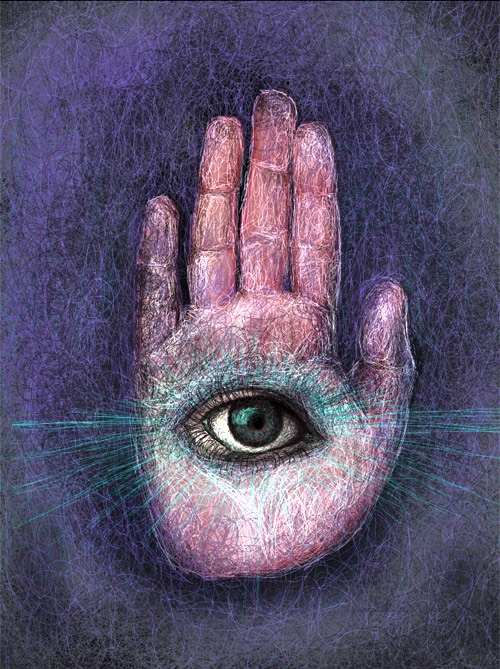 |
|
the egyptian Eye of Horus aka ouidjat drawn in the hand's palm 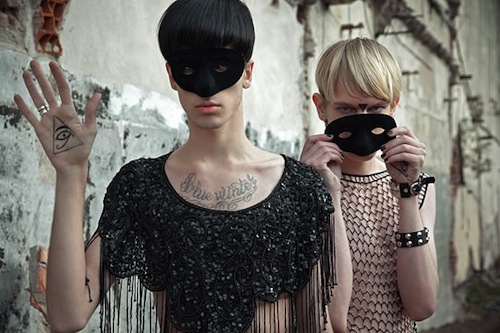
In Egyptian myth the eye was not the passive organ of sight |
... "These photographs are from a series titled ILLUMINATI, by [Buenos Aires-based fashion photographer] Antonella Arismendi. ... The image of the All Seeing Eye (The Eye of Providence) is a symbol showing an eye surrounded by rays of light and usually enclosed by a triangle. It represents the Eye of God keeping watch on humankind, Divine Providence. The symbol dates back to ancient Egypt and was symbol of protection and royal power from deities, in this case from Horus. The most notable modern depiction of the eye is the reverse of Great Seal of the United States, which appears on that nation's One Dollar bill." - ladylavona.blogspot.com 26 sep 2009
|
|
Massive 1,100+ year old Maya site discovered in Georgia's mountains by Richard Thornton, Architecture & Design Examiner 21 December 2011 Richard Thornton, author of the soon-to-be-published Itsapa ... the Itza Mayas in North America, on Georgia archaeological site 9UN367 and the evidence of Mesoamerican immigration ('Maya diaspora') to North America, to be published in 2012: "The previously unknown story is fascinating. For example, the famous "eye on hand" motif found on Native American art throughout the Southeast and Midwest is the symbol of the Maya's supreme deity, Hunab-ku." |
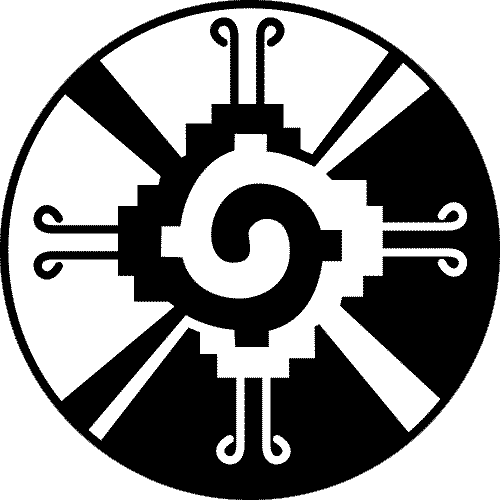 a Hunab Ku symbol |
am familiar with the northeast Georgia area, appreciate Covarrubias' theory of northern migrations from Mexico, and preach the northern migration of corn from the Maya and Aztec that was the basis of Mississippian culture here in the Southeast USA. but Thornton's statement equating the eye-in-hand icon with Hunab-ku raises the skeptic hackles in me. below are the images of the eye in hand in Native American art, or more specifically in the art of the Aztec & Maya. - tpk 24dec2011 |
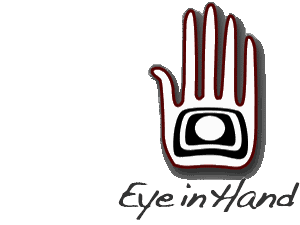 |
a visual study of an historic multi-cultural icon by tom kunesh
|
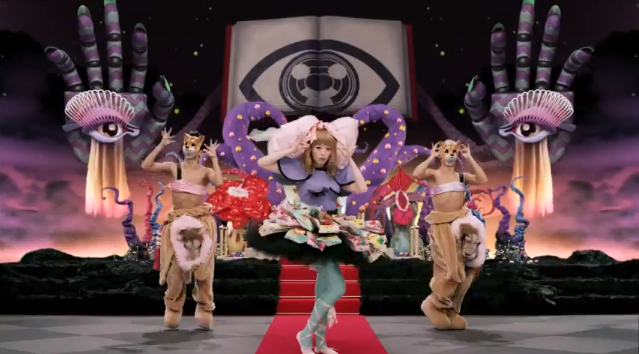
|
"Tsukematsukeru" [false-eyelashing] pop song video on YouTube eye-in-hand appears 3:26 - 3:53 performed by Kyary Pamyu Pamyu, fashion blogger, model, entrepreneur of fake eyelashes called "Harajuku Doll Eyelashes by Eyemazing x Kyary"
produced by Yasutaka Nakata (capsule).
The dominant motif is fake eyelashes, which |
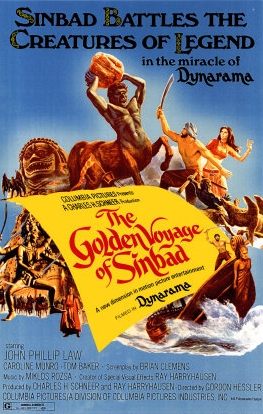
The Golden Voyage of Sinbad (1974)
thanks for the heads-up, B. |
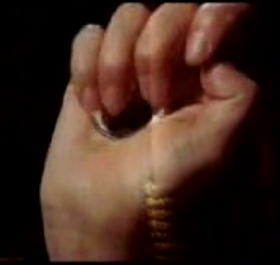
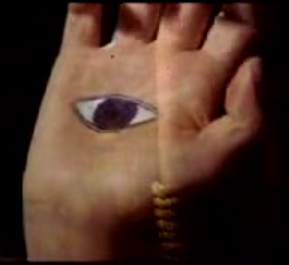
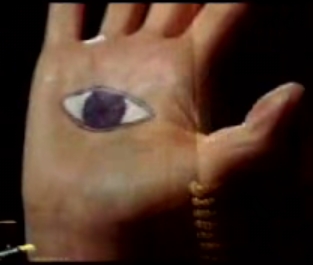
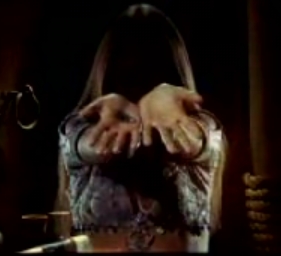
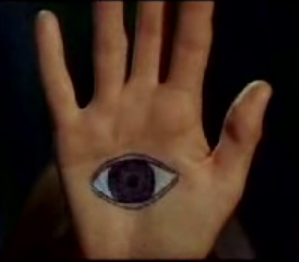
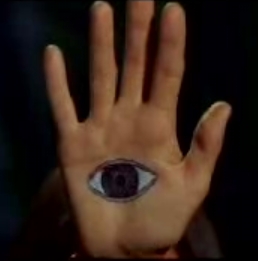
|
DG's branded hand in "Tin Man"
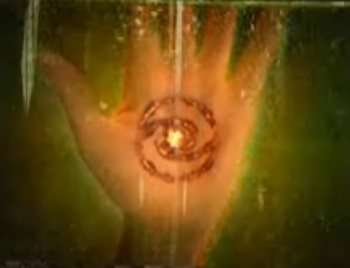 |
common North American counter-clockwise tornado/cyclone spiral: NOT an eye in hand. and actually a symbol of a most rare type of North American anticyclonic (clockwise) tornado.
DG = Dorothy Gale |
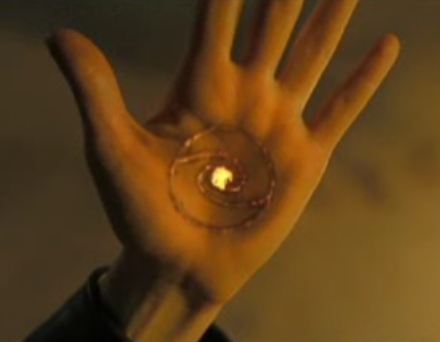
|
 |
logo of Second Life aka Second Life Hand Design ... "a 3D online digital world imagined & created by its residents." |
|
Pan's Labyrinth
el hombre palido en
el Laberinto
por Guillermo del Toro |
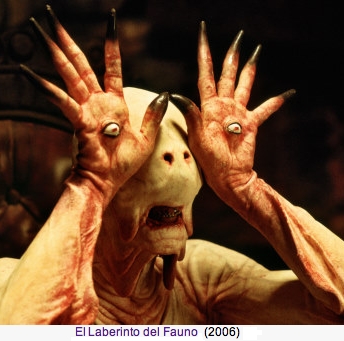
Did the Pale Man in Pan's Labyrinth come from a story? |
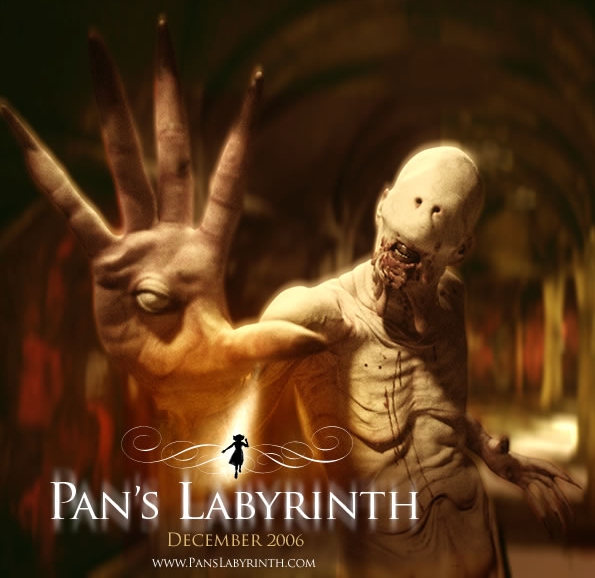
|
one of the marvelous things about this film is that it shows live eyes-in-hands in action connected to a living breathing moving body with no eye-holes in its head. it was genetically born with its eyes in its hands. 90% of all other eyes-in-hands are dismembered & removed from a human body, yet magically alive. a standalone hand with an eye in it. the other eyes-in-hands that are connected to living humans also have eyes in their heads, brain-connected eyes to a person with self-identity, raising the question of the purpose of the optical redundancy. | ||
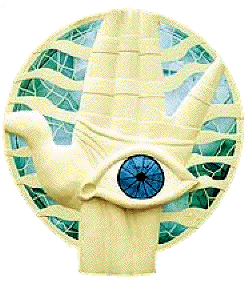 A Mão de Deus por Marianne Peretti 1994 Sala do Tribunal Pleno, Superior Tribunal de Justiça, Brasília, Brazil Muitos agradecimentos a Marcellus Lima em Brasília. 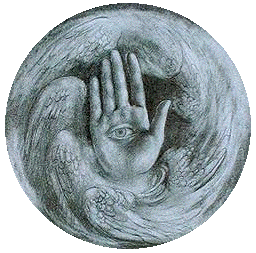
Kahlil Gibran "the Divine World" one "of the gibranean visions (1908-1914)" thanks for pointing this out, dgb
a spoof on this site by a friend |
the Eye in the Hand
| |||||||||||||||||
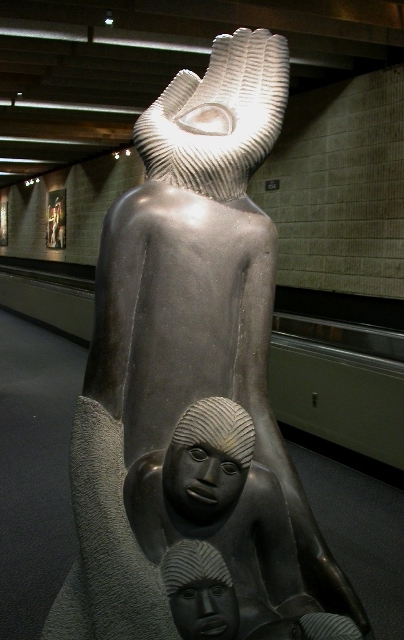 |
eye in hand Lameck Bonjisi Zimbabwean sculptor |
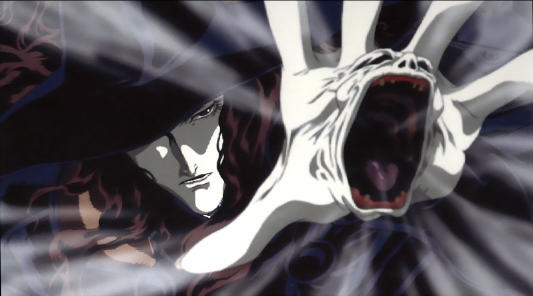 |
LEFT HAND of Vampire Hunter D
A parasitic entity in the shape of a human face on D's left hand. |
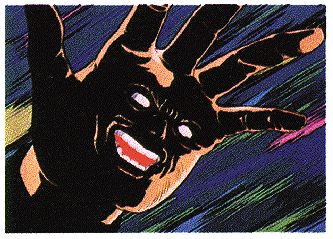 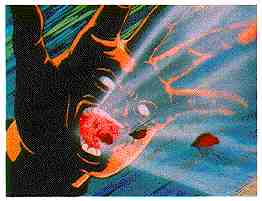 |
five
6-fingered eye-in-hand
TYLER C. GORE
WWW.TYLERGORE.COM
Tyler Gore is a graphic designer and a writer who features this hand-eye symbol prominently on his site.
"I've been intrigued by the hand-eye symbol since I was a kid, although I never actually explored its wide distribution and meanings. I think I first encountered it in a Sinbad movie (The Golden Voyage of Sinbad ca. 1974?) at a drive-in, which has a scene featuring a girl with an eye tattooed on her hand.
CRUX SCUTEM
latin:
merci à M. Radun de Toronto
White Tara, Goddess of Compassion, the Divine Mother
White Tara - Goddess of Compassion
White Tara: The Divine Mother TC02
Sage Woman 2003 Calendar: Blessings from the Hands of the Goddess
I AM FREE
logo of the
"the legendary All-Snatching & All-Looking Hand & Eye of Bob"
Lydia J. Hess - LydiaHess.com
in Rolling Stone,
- dicho nevadaño
Ancient Art & Architecture (AA&A) Collection Ltd
$19 - Amazon.com Price: $13.49, 160 pages, Chartwell Books / Carlton Books;
ISBN 1858687292 (July 15, 2000) Paperback;
ISBN 0785806423 (October 1996) Hardcover Printed in Italy
"Raymond J. Walters explores how humankind has used and exploited these stones throughout the ages and across the world, not just for their beauty, but also the magical powers many believe they possess."
"In over forty years of traveling and studying the human species, Desmond Morris, author of The Naked Ape, has noticed that everywhere he has been, people always have some kind of lucky charm, protective amulet or talisman. The form it takes varies from country to country and culture to culture, but in each place the favorite charm is treated very seriously and endowed with helpful, magical properties. Sometimes it is meant to protect its owner from bad luck, sometimes its meant to bring good luck. Always there is a fascinating history or symbolic background to the talisman. In Bodyguards, Desmond Morris shares his life-long fascination with the universal human belief in the power of charms and amulets to protect from evil and bring the bearer luck. Beautifully illustrated throughout with full-color photographs of more than one hundred amulets from his own collection, Bodyguards provides an account of the traditions and mythology behind these amulets, charms, talismans, symbols and sayings, sharing their fascinating history and stories explaining why they have become so popular."
Made of fine lead-free pewter
Stone Pallete, plate 93
Rattlesnake Disc - The rattlesnake disc is probably the most famous item found at Mound State Monument. We have no explanation for the meaning of the designs on the face of this 12.5 inch disc. It is thought that the rattlesnakes bound at two points mean war. The Hand with the Eye in the center probably represents those of the creator. Since no other disc is so elaborately inscribed, archaeologists have reason to believe that this disc was one of great importance and was probably used in religious and/or war ceremonies.
Perhaps the Mississippian Hand-and-Eye design represents a crystal held in a man's Hand, symbolizing the ability to see into the future, although this interpretation must remain conjectural until other evidence presents itself.73 p 169
note 73: James Howard has suggested that the Hand and Eye design had something of the meaning the Hand design had for the Plains Indians in more recent times. Namely, that it was associated with warfare, and that it might have meant, as among the Omahas and Dakotas, that the warrior wearing it had been struck or wounded by the enemy (Southeastern Ceremonial Complex, 29-34). LIke the anomalous feathered serpent, the use of the Hand and Eye design also occurs in the art of the Northwest Coast and in Mesoamerica, with some similarity to art motifs in China during the Shang and Early Chou dynasties. Cf. Robert L. Rands, "Comparative Notes on the Hand-Eye and Related Motifs," American Antiquity 22 (1957):247-57. p 516
-- Charles Hudson, The Southeastern Indians, University of Tennessee Press (Knoxville 1976) chapter 3: The Belief System
It is not the purpose of the following remarks to consider the more far-flung of these correspondences. The comments, rather, are an expansion of a paper given before the Eleventh Southeastern Archaeological Conference at Moundville, Alabama, in November, 1954. As such, their point of departure is the eastern United States, with particular reference to the art of the Southern Cult. Nevertheless, the culture areas from which comparative material is drawn, Mesoamerica and the Northewest Coast, must be asknowledged by any but an arch diffusionist to be geographically remote. No implication is made that the various art forms to be discussed are necessarily related historically.
To give additional perspective to the specific comparison which follow, it should be noted that, in Southeastern art, hands lacking an Eye at the palm have been cited as showing Mexican affiliations. Moore (1907: 346) made comparisons with the severed Hand as depicted in Mexico, and more recently particular attention has been directed to similar subjects, strongly Moundville-like in character, at Tazatlán in Tlaxcala (Griffin 1949: 97; Noguera 1927; Marquina 1951, Fot. 34; Moore 1905, 1907). Mention might also be made of the Moundville-like aspects of one of the Classic Veracruz yokes, which shows the human radius and ulna stripped of flesh but attached to a Hand from which the flesh has not been removed (Proskouriakoff 1954, Fig. 2, Yoke 13; Moore 1905, Fig. 147). A description relating to the Aztec is very suggestive of the Southeastern Death /end 247/begin 248/ Cult in this general connection. The passage is from Sahagún and deals with the war god, Uitzilopochtli: "And the cape ... was designed with skulls, with the palms of hands, with hip bones, ribs, legs, the lower arm bones, and with the outlines of feet" (Anderson and Dibble 1950-54, Bk. 2: 69).
In their paper on the Southern Cult, Waring and Holder (1945) illustrate several variations on the Hand and Eye motif (Fig. 1). The Eye is occasionally replaced by a cross in a circle or by an ellipsoidal to rectangular element. These forms usually occur at the palm of a Hand which is extended downward, although examples are not wholly lacking in which the back of the Hand is shown or the Hand is opened upward (Moore 1905, Figs. 7, 173).
Additional examples occur of this Mexican version of the Hand and Eye motif. On a stone teponaztli (drum) in the Museo Nacional, horizonally [sic] extended hands appear on a grotesque face (Fig. 3 a). The hands overlie the eyes, which show through the palm of each. A tenoned stone hacha in the Museo de Oaxaca is reproduced as Figure 2. With lid clearly visible, an Eye this time is showing through the back of an open Hand. Fingers upward, the Hand once again is detached and placed against the face at the region of the Eye.
A pattern thus existed in Mexico for the Hand to be superimposed over some facial feature, with this anatomical feature showing through the Hand. In the Mexican codices, numerous examples occur of the Hand over the mouth, the outline of the lips appearing against the Hand. In some instances the lips and teeth are completely surounded by the the Hand (Codex Borgia: 48), in this respect being identical to the Eye as illustrated in Figures 1 d, 2, and 3 a. In other codex portrayals, the indentation of the lips forms part of the hand's profile (Fig. 3 b). The latter treatment seems to occur in the art of the Southern Cult (Fig. 3 c). Phillips (1940: 356) calls attention to "the Hand on jaw" as one similarity between the Southeast and Mexico.
Fig. 2. Thin stone head or hacha, Oaxaca (?)
The Hand and Eye symbol in Aztec Mexico was not restricted to examples in which an Eye shows through a superimposed Hand. An apparent variant of the motif (Fig. 4), perhaps mainly associated with the earth monster, shows fangs in conjunction with the eyes and locates these profile faces on hands, feet, elbows, and knees. The faces, and particularly the eyes, tend to be so placed as to lie on the wrist and ankle, rather than directly on the palm of the Hand or the sole of the foot. Schuster (1951, Figs. 43, 44) illustrates 2 examples of the earth deity whose joints are overlaid with these grotesque faces; similar forms appear in Nicholso (1954, Figs. 3, 4), Proskouriakoff (1954, Fig. 9 e), and Peñafiel (1910, Pls. 51, 72, 74). That the nucleated circles at the region of the hands and feet in these representations are to be identified as eyes is indicated by their near identity in treat- /end 248/begin 249/ ment to the eyes of the associated skulls. Compare also the eyes in Figure 1 d. Moreover, a 16th century French source states "... the goddess of the earth, Tlatechutli ... had eyes and mouths at every joint, with which she shapped like a savage beast" (Jonghe 1905: 28, quoted in Schuster 1951: 16).
The Aztec wind god Quetzalcoatl is also shown with faces at his knees, a detached Eye appearing at each elbow (Schuster 1951: 16; Seler 1902-23; Vol. 2: 955, Fig. 3). The placing of eyes on the elbows corresponds to Figure 3 d, from Spiro, Oklahoma. At Spiro it is the forked Eye, one of the motifs of the Southern Cult, which overlies the elbow, the Eye itself being centered on the elbow joint. The design not only offers a specific corespondence to Mexican material but suggests that, in the eastern United states, an association existed between eyes and joints. Adena* designs on the Lakin A and Gaitskill tablets (Figs. 5, 6), which are thought by Webb and Baby (1957) to be the prototype of the Hand and Eye motif, may be compared. In these designs, nucleated circles occur at the joints of highly stylized figures -- apparently at the shoulder, hip, elbow, ankle, and wrist. Rather than being placed at the wrist joints, however, the circles could sometimes be thought of as occurring directly on the "hands" or "bird feet" -- an impression which is especially pronounced in Figure 6. It may be noted that the use of nucleated circles in the Adena designs offers another correspondence to Mexican art forms (compare Figs. 1 d, 4, 5, 6). Finally, mention may be made of a nucleated circle silhouetted at the "palm" area of a sheet mica eagle foot in Hopewellian art (Shetrone 1930, Fig. 62). While the sample is small, the available data suggest the possibility that, in the eastern United States, there was a late substitution of the realistic Eye for the nucleated circle as a marking to be associated with joints or hands. In earlier times, perhaps, the emphasis was on the marking of joints, in Cult art on the direct association of the Hand and Eye. Willey (1948) discusses other treatments accorded the back of the Hand, knuckles, and wrist on a pre-Cult horizon in the Southeast. It would seem that considerable elaboration of art motifs may have been taking place, rather than a simple linear development.
Fig. 4. Sculptured Aztec earth monster
Fig. 5. Lakin A tablet, West Virginia
Within Mesoamerica as a whole, the basic forms of the Maya hieroglyphs were established on a horizon considerably preceding known occurrences of the Hand and Eye motif. The marking of a wrist with a nucleated circle is present in a sizable body of glyphs. It might be argued, therefore, that in Mesoamerica wrist markings were earlier than the direct assocation of the Hand and Eye, at least as a favored art form. In any event, extant examples of the /end 249/begin 250/ Hand and Eye motif apparently cluster on a late (Aztec) horizon; the earliest illustrated (Fig. 2) presumably dates from the Classic period. Tenoned and sometimes perforated or portraying the skull, the Oaxaca type of hacha seen in Figure 2 tends to have specialized features provisionally associated with the Late Classic horizons (Proskouriakoff 1954: 79-80; Seler 1902-23, Vol. 2: 363, Figs. 104-110 b).
It has been seen, in the art of both Mexico and the Southern Cult, that at times the Hand was superimposed on some portion of the face, so that the Eye or the mouth showed through the Hand. A partial analogy is suggested in another Maya glyph (Fig. 3 g), where a Hand is so placed on the jaw that the outline of the thumb coincides with that of the lower lip (compare Fig. 3 b, c). Thompson (1940: 132) points out that in this glyph (zero or completion) the Hand is connected with death, thereby corresponding to its association in Mexico -- as also in the Southeast. The association of death elements with a Hand having ellipsoidal markings is also present in the glyph reproduced in Figure 3 f (compare Thompson 1950, caption to Fig. 5, 43-5).
As indicated, the encircled cross substitutes for the Eye at the palm of the Hand in certain Southeastern designs (Fig. 1 c). Partially comparable forms exist in Maya hieroglyphic inscriptions and art. (1) Clenched hands occur with crossed bands set against the palm (Fig. 7 a; Thompson 1950: 40, Fig. 51, 4). Not only is the Hand clenched and held upward, thereby differing from Southeastern examples, but the X-shaped design formed by the crossed bands differs in detail from the cross-in-circle. (2) In the Maya glyph for west, the kin (sun) sign sometimes apprears as an infix in the Hand (Fig. 7 b, c; Thompson 1950: 251, Fig. 41, 18, 19, 21, 33). Again the Hand is clenched. Moreover, the kin element appears at the back of the Hand, toward the wrist, rather than in the palm. In Figure 7 c, however, the variant of /end 250/begin 251/ the kin sign, somewhat approaches the Southeastern cross-in-circle in appearance (Fig. 1 c). It is apparent that the correspondences just cited are not truly specific ones. Their function (glyphic versus more purely decorative or, at best, grossly symbolic) is of course in sharp contrast. In the various designs, nevertheless, the Hand is associated with perhaps related elements: a so-called "comic symbol" (Fig. 1 c), sun sign (Fig. 7 b, c), and possible segment of an astronomical band (Fig. 7 a). Conceiveably, then, there could be a common concept involved which finds expression in these somewhat divergent forms.
Figure 8 illustrates a compound wooden mask of the Kwakiutl Indians, from the Northwest Coast. To the left, attached to an arm, a 4-fingered Hand extends upward. At the palm of the Hand is a rectangular element with rounded corners, very comparable in appearance to that found in identical position in the art of the Southern Cult (Fig. 1 b). To the right appears an element which may be an Eye in the palm (or back) of the Hand. The Hand is so placed that the supposed Eye occurs over the region in which the mask's Eye would normally appear. If an Eye is actually depicted this placement is striking indeed, in view of the Mexican examples in which an Eye shows through a superimposed Hand (Figs. 1 d, 2, 3 a). On the other Hand, the bent arm with /end 251/begin 252/ rounded, boneless appearing elbow finds a close correspondence in the previously cited Adena designs (Figs. 5, 6). Compare the "hocker" motif of Covarrubias (1954: 34, 190, Figs. 5-9, 51-5).
A brief consideration of certain aspects of Northwest Coast art may be in order, in view of the correspondences between the designs shown on the Kwakiutl mask and the Hand-Eye motif in the Southeast and Mexico. Boas (1927: 253) notes that in Northwest Coast art, "The Eye design appears in a variety of forms ranging from a large double Eye to a circular pattern with black center." Exemplified in Figure 7 g, the latter treatment agrees genearlly with the supposed Eye in Figure 8 and to a design, shown on the foot of a bird, in Figure 7 d; compare Boas (1927) Figures 191, 192, 244, 166 g. Compare further the nucleated circles which mark bird feet on the Adena tablets (Figs. 5, 6). Boas (1927: 252) also describes the Eye design as consisting of "a round or oval field ... commonly so placed that it corresponds to the location of a joint." Accordingly, it often appears at the wrist, as well as the shoulder, hip, and ankle or, in the case of the whale, at the base of the tail or dorsal fin. As a nucleated circle, the "Eye /end 252/ begin 253/ design" is sometimes considered to be a cross section of the ball and socket joint (Fig. 7 d). The "Eye design" is not only substituted for the joint (Fig. 7 e) but occurs in the mouth of an animal, at the tail or wings of birds, and as decorative fillers (Boas 1927: 158, 204, 252-3).
The so-called Eye appears, therefore, in a wide variety of contexts in the art of the Northwest Coast, and once a process of elaboration such as would tend to bring this about was under way, it might be a fairly simple matter for the design to be shifted from the wrist joint to an area roughly centered on the palm of the Hand. ...
-- Robert L. Rands, "Comparative Notes on the Hand-Eye and Related Motifs", American Antiquity 22 (1957):247-57 (Center for Archaeological Investigations, Southern Illinois University, Carbondale IL; retired 1990)
*"Clarence B. Moore (1852-1936), a wealthy Philadelphia socialite, paper company heir, and photographer made the archaeology of the Southeast his passion beginning in the 1870s." - Jeffrey M. Mitchem
_Sun Circles and Human Hands:
"Since the archeological investigations of the sites of Etowah and
Moundville, it has been apparent that there exists in the southeastern
United States a complex of specific motifs and ceremonial objects. ...
The Hand and Eye consists of an extended Hand containing a naturalistic Eye in the center of the palm. Both nails and volar markings are frequently shown upon the same example. The Eye may be replaced by a cross in a circle. (Thurston, 1890. Fig. 40.
Motifs, plate 17, VII. the Hand and Eye
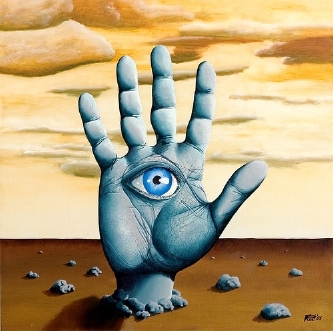
by Poul A. Costinsky
www.polyrealism.com
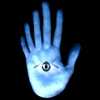
'From The Vault 1' Collection
Subconscious Communications
posters from the Vault 1 series
all designed by Simon Paul
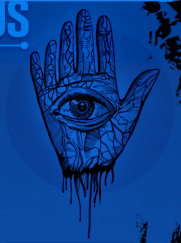
Subconscious Communications
an independent record label
based in Toluca Lake, California

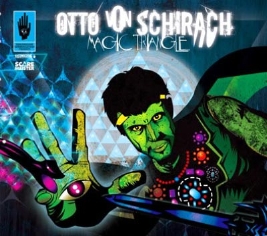
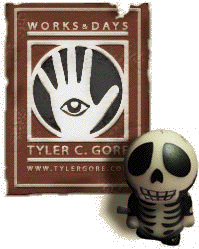
works & days
But I've been drawing it since I was a small kid."
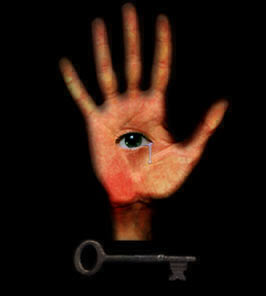
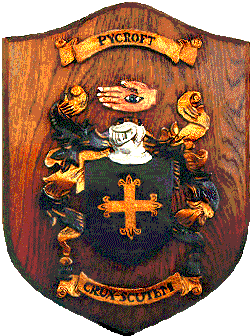
PYCROFT family
coat of arms
crux = cross
scutum = shield
The Tattooed Map
Barbara Hodgson . fiction . 1995 . 120 pp
who notices a strange mark on her hand
as she is traveling through Morocco.
The mark slowly gets bigger and starts
to resemble a map, which leads her on a
frightening journey through the country.
Written in the form of a journal,
this is an intriguing mystery,
unraveled in the desert towns
of North Africa. 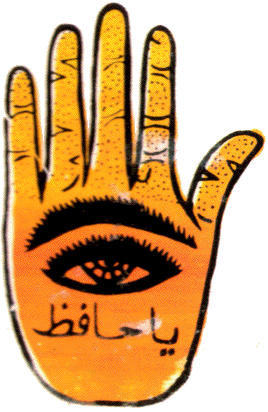
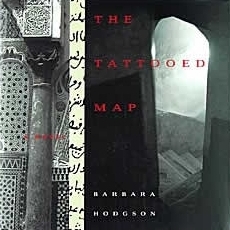

1882-1940
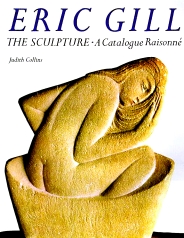
by Judith Collins (Overlook Press 1998)
thanks to Mike W. for the reference
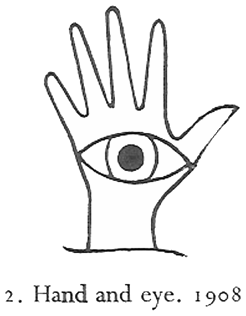
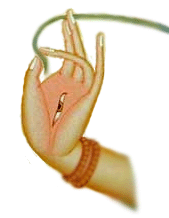
detail - 4 of her 7 eyes (3 in her head, 2 in the palms of her hands, and 2 in the soles of her feet),
White Tara / Weiße Tara Dharmapala Thangka Centre, Tibetan Buddhist School of Thangka Painting
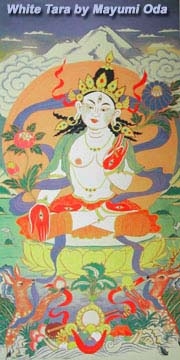
by Mayumi Oda
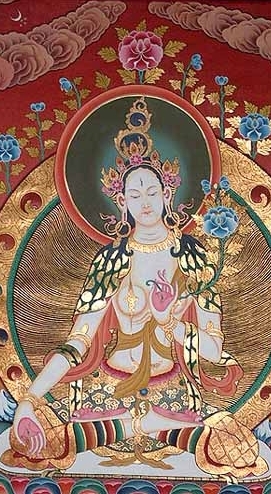
Tibetan Thangka Painting, 1.8 ft x 2.5 ft
$275.00, Discounted: $206.25, SOLD
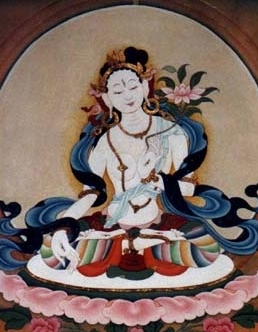
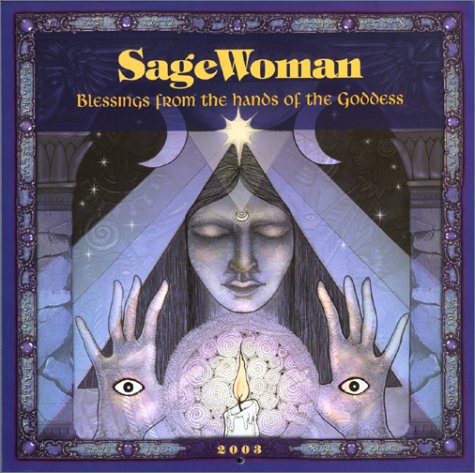
List Price: $12.95 (Amber Lotus ISBN: 1569373213; Wall edition July 2002) SageWoman, the best-selling magazine of women's spirituality, joins with Amber Lotus to create a new level of excellence in Goddess art and inspiration. The 2003 SageWoman Calendar presents portraits of 12 goddesses whose blessings enrich and empower women in their everyday lives. The calendar features six goddess artists who are widely considered the most accomplished and well-loved artists in the field, including Katlyn Breene, Joanna Powell Colbert, Marcia Snedecor, Sandra Stanton, Tanya Stewart and Kris Waldherr.
Accompanying each image is text by Lunnaea Weatherstone, priestess and writer, who weaves a tapestry of wisdom and wit that illuminates the common threads of sacred feminine energy worldwide. Each month offers seasonal themes, folklore, festivals and much more - adding up to 365 ways to celebrate the Goddess in every woman.
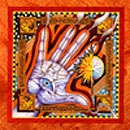
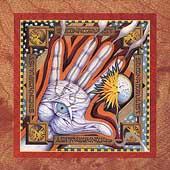
music/band .
Somnambulist - The Paranormal Humidor
Released: 2001 .
Label: Laser's Edge .
Chattanooga, Tennessee USA
somnambulism - an abnormal condition of sleep
in which motor acts (as walking) are performed
![I AM FREE - Eye in Hand logo of the Internet Arts Museum for Free (IAMfree) logo [ error 403: Forbidden /no access on 29march98 ]](eyeinhand2.gif)
Internet Arts Museum for Free (IAMfree) 1995
site down/no access on 29march98 /
a 1995 review:
Lectro-Art was featuring Dave Parmley, who was inspired by eastern philosophical concepts in design and his own hand (you get the connection, if you can see the opening image on this site). He has done the IAMfree logo and another of his works was available for downloading.
![]()
![]()
Icon, Universal Church of the Subgenius Triunfante, official global purveyor of three-layered Slack®
"The Names Project/AIDS Memorial Quilt"
by Lydia J. Hess
_The 1995 Creative Illustration Book_
(Black Book Marketing Group: NY 1995) p 351
Portland, Oregon USA
- see below and again ]
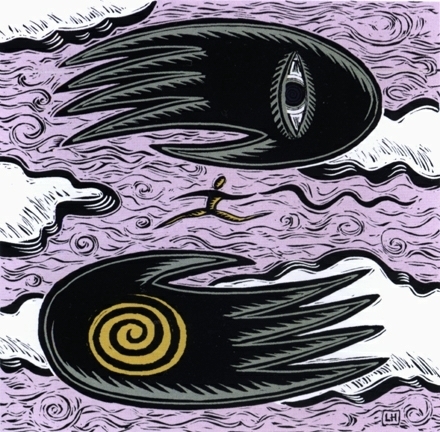
the Eye-in-Hand as the all-seeing (Eye), all-powerful (Hand) U.S. National Security Agency (NSA) and FBI (Federal Bureau of Investigation).
Log Cabin Studio
October 12, 2000
"NetBook.rs" p11,
for "The Private Obsessions
of Bob Barr,
Culture Warrior"
by Erika Casriel 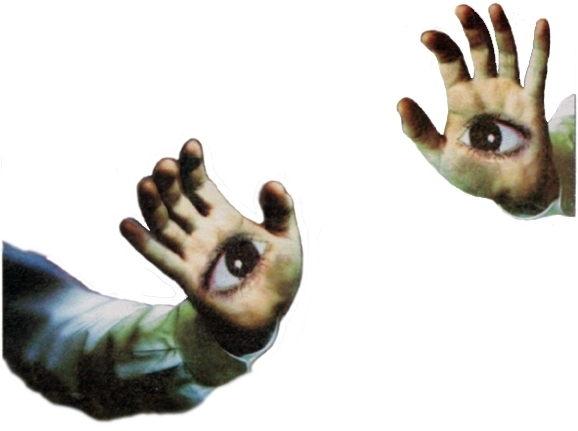
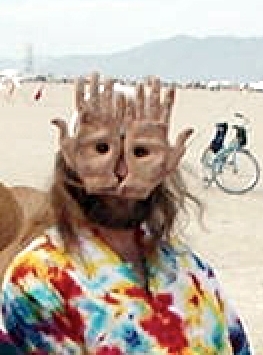

"I built a mask this year ..." 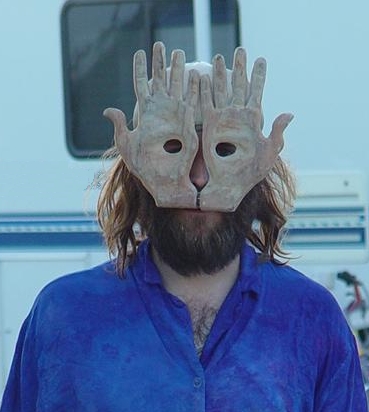
Dan Lyke at
the Burning Man 2000 & 2002
Yep. Roughly. Traced onto redwood and carved from there.
have hands
in their eyes.
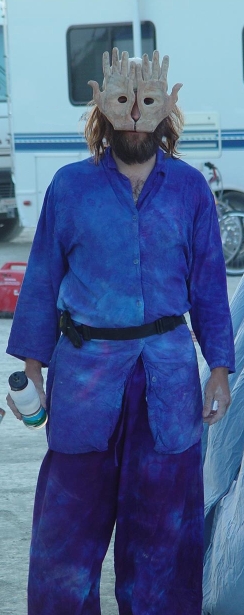
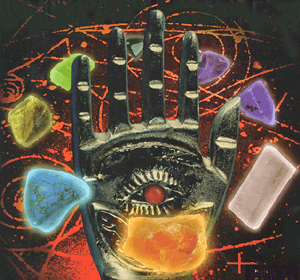
by Raymond J. L. Walters
410-420 Rayners Lane - Suite 7, Pinner, Middlesex HA5 5DY
United Kingdom Phone: 44-208-429-3131 Contact: Michelle Jones
library@aaacollection.co.uk
http://www.aaacollection.com
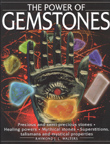
in Body Guards : Protective Amulets & Charms by Desmond Morris
hardcover, 224 pages (October 1999) Element; ISBN 1862045720
list price: $30, amazon.com: $21
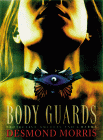
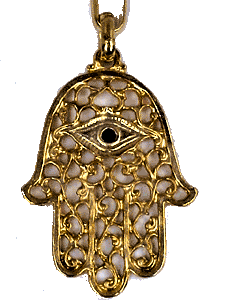

Filigree Hamsa
Protective Hand amulet in traditional
Middle Eastern filigree style.
Height 29 mm
GP311G - 14k gold $100
GP311S - sterling silver $26
Copyright © 1994, 1995 - Macom Networking "Hamsa" (open Hand)
Jewish Communication Network:
Rosh Hashanah Holiday Gift Ideas: Hamsa 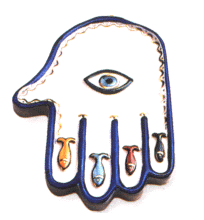
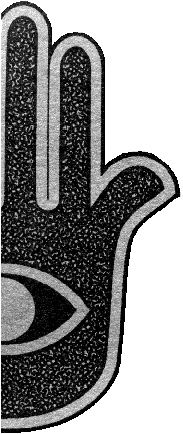
"The universal symbol called Humsa by the Hindus is a powerful protection amulet in Asia and is often called the All Seeing Eye of Mercy.
In Tibet it is used for banishing fear and oppression.
This same symbol was also used by Native Americans.
In the Middle East it was called the All Seeing Eye of God and the Eye of Maat, and was thought of as a great protector."
All-seeing protector
Central Casting95 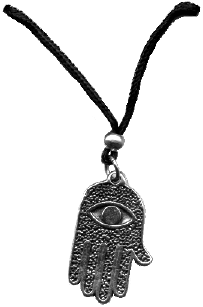
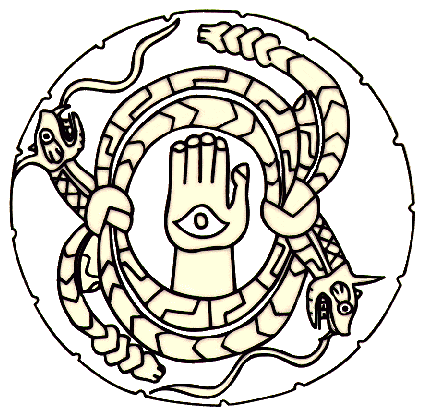
Ceremonial Objects, plate 20
engraved stone disk "Rattlesnake Disk." Sun circle, Hand and Eye, and entwined snake design carved on a circular sandstone disk
found at the prehistoric site of Moundville, Alabama. Moundville, Moore, 1905, fig. 7.
Ceremonial disk found at Moundville, Alabama
with rattlesnake and Hand and Eye design;
12.5" diameter (Courtesy, Alabama Museum
of Natural History).
- Sun circles and human hands: the southeastern Indians - art & industry edited by Emma Lila Fundaburk & Mary Douglass Foreman, Southern Publications, Fairhope, Alabama 1957,1985
- display placard at Mound State Monument, Moundville
The Choctaws believed that the Sun watched them with its great blazing Eye, and so long as the Eye was on them they were all right, but if the Eye was not on them they were doomed. p 126 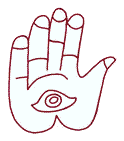 Almost 50 years ago, Clarence B. Moore* called attention to the presence of "the symbol of the open Eye on the open Hand" in both the Southeastern United States and Mexico (Moore 1907: 346). The design has achieved some renown as one of the motifs characterizing the so-called "Death Cult" in the Southeast and has also continued to be cited as an indication of Middle American connections (for example, Phillips 1940: 356). Rather little has been done in following up Moore's observation through detailed comparative studies between the 2 areas. Recently, however, Schuster (1951), and following him, Covarrubias (1954), have touched upon the Hand and Eye motif in these regions as part of a larger problem -- that of cultural connections between the Old World and the New. They have noted the existence of eyelike forms on the Hand in the art of various American cultures, extending in a broken distribution from Peru (Schuster 1951, Fig. 82) to the Northwest Coast (Schuster 1951, 16-17; Covarrubias, 1954: 35, 190, Fig. 56). The same writers have presented extensive datga which would seem to indicate a connection of the Hand and Eye with various markings, including faces and nucleated cirles, on the joints of arms and legs (see also Schuster 1952; Seler 1902-23, Vol. 2: 955-6).
Almost 50 years ago, Clarence B. Moore* called attention to the presence of "the symbol of the open Eye on the open Hand" in both the Southeastern United States and Mexico (Moore 1907: 346). The design has achieved some renown as one of the motifs characterizing the so-called "Death Cult" in the Southeast and has also continued to be cited as an indication of Middle American connections (for example, Phillips 1940: 356). Rather little has been done in following up Moore's observation through detailed comparative studies between the 2 areas. Recently, however, Schuster (1951), and following him, Covarrubias (1954), have touched upon the Hand and Eye motif in these regions as part of a larger problem -- that of cultural connections between the Old World and the New. They have noted the existence of eyelike forms on the Hand in the art of various American cultures, extending in a broken distribution from Peru (Schuster 1951, Fig. 82) to the Northwest Coast (Schuster 1951, 16-17; Covarrubias, 1954: 35, 190, Fig. 56). The same writers have presented extensive datga which would seem to indicate a connection of the Hand and Eye with various markings, including faces and nucleated cirles, on the joints of arms and legs (see also Schuster 1952; Seler 1902-23, Vol. 2: 955-6).

Fig. 1. Variants of the Hand and Eye motif. a, b, c, Southeastern United States (after Waring and Holder 1945, Figs. 1, 7 a-c);
d, Lienzo de Tlaxcala: 40 (after Seler 1902-23, Vol. 2: 569, Fig. 99). The Hand and Eye design in Mexico cited by Moore is shown in Figure 1 d. It is from the Lienzo de Tlaxcala -- again Tlaxcala appears as a place where the Hand is emphasized in Southeastern fashion -- and dates from shortly after the Spanish Conquest. A shield is depicted, decorated as a grotesque face. Two detached hands are placed over the area of the eyes in such a way that an Eye is showing through the palm of the each Hand. The hands are extended upward, not downward as is usually the case in the Southeast.
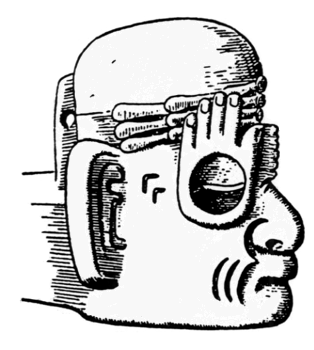
(after Seler 1902-23, Vol. 2:363, Fig. 110 a).
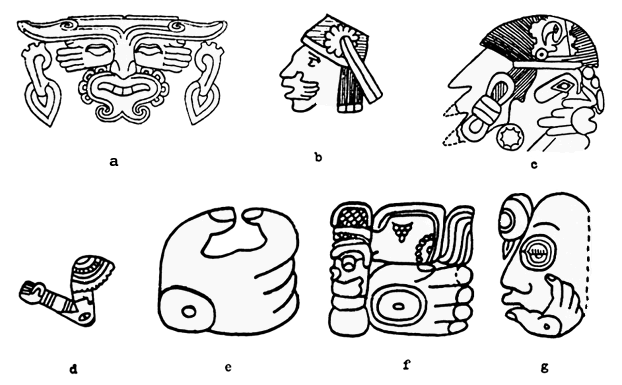
Fig. 3. a, sculptured face, identified as Aztec god Macuilxóchitl (after Castañeda and Mendoza 1933, Pl. 13); b, head of the Mexican god Macuiltochtli (after Seler 1902-23, Vol. 2:488, Fig. 37); c, head of a sheet-copper eagle, Dunklin County, Missouri (after Moorehead 1932, Fig. 8 a); d, arm of human figure on engraved shell gorget, Spiro, Oklahoma (after Burnett and Clements 1945, Pl. 60); e, Maya day sign Manik, Chichén Itzá, Yucatán (after Thompson 1950, Fig. 7, 44); f, Maya glyph (prefix with haab completed), Piedras Negras, Guatemala (after Thompson 1950, Fig. 5, 43); g, Maya glyph for completion, Copán, Honduras (after Thompson 1950, Fig. 25, 39).
[ * The Adena culture was a conglomerate of many Indian communities that inhabited the Central and Southern regions of Ohio in the first millennium BC. The Adena people lived in villages and survived by hunting, fishing and gathering wild plants. Although the Adena culture survived for many centuries (500-100 BC), much of what we know of them today is drawn from mounds.
Their location on the Ohio River provided them an accessible passageway to and from New York, Pennsylvania, and southern Illinois. Many Adena artifacts have been found in these regions. Their location had many resources and supplied them with the copper and mica that they traded. The Adena culture is also distinguished by their siltstone smoking pipes. These pipes are fine examples of prehistoric Indian art. The building of the mounds began around 500 BC.
-- from http://campus.northpark.edu/history/WebChron/NorthAmerica/Adena.html ]
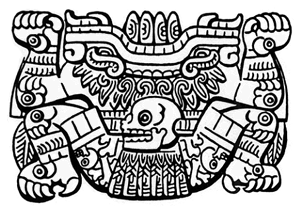
(after Covarrubias 1954, Fig. 8).
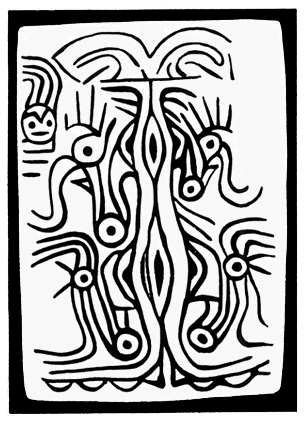
(after Webb and Baby 1957). A nucleated circle, composed of rather widely spaced concentric lines, occurs frequently in connection with the Hand in Maya hieroglyphs. The element usually appears on the back of the Hand, at the area of the wrist (Fig. 3 e). Occasionally, however, the design is shifted to the back, or possibly the palm, of an extended Hand (Fig. 3 f). Correspondences with these glyphs my be noted in the eastern United States, that is, the Adena joint markings and the Cult Hand and Eye motif. (In the latter connection, compare especially variations on the order of Brown 1926, Fig. 279). The normal position of the circle at the wrist in the Maya glyphs suggests that a joint mark may have been the basic concept, rather than a marking on the upper part of the Hand. Nucleated circles are present both in the Adena and Maya motifs. Comparisons, then, are closer to Adena than to the Hand and Eye in the Southern Cult.
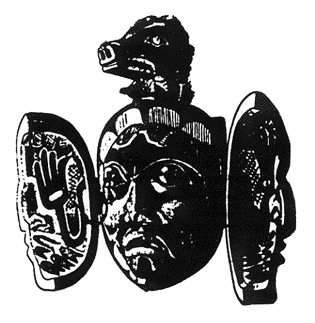
Fig. 8. Compound Kwakiutl mask
(after Hodge 1907-10, Pt. 1: 814).
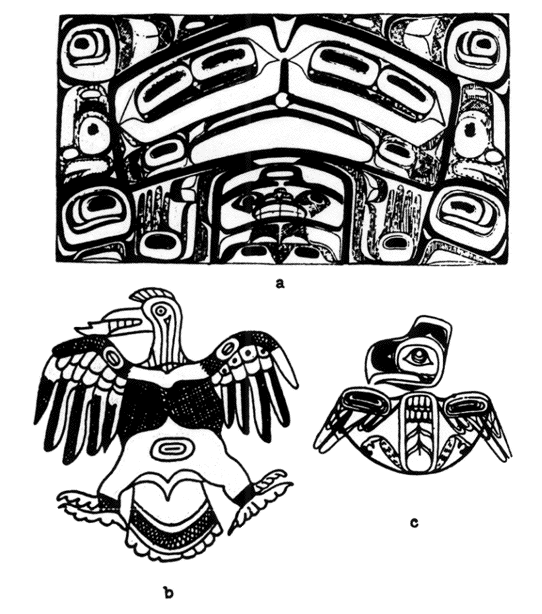
Fig. 9. a, painted Tlingit box (after Boas 1927, Fig. 276);
b, woodpecker, Moundville, Alabama (after Waring and Holder 1945, Fig. 4 e)
c, Tsimshian painting representing an eagle (after Boas 1927, Fig. 241).
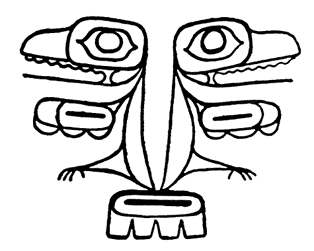
Fig. 10. Haida tattooing representing a duck
(after Boas 1927, Fig. 226).
The Hand and Eye Motif (image from "Certain Aboriginal Remains of the Black Warrior River" by Clarence B. Moore, Journal of the Academy of Natural Sciences of Philadelphia 13:125-244, 1905.)
the Southeastern Indians - Art and Industry_
edited by Emma Lila Fundaburk and Mary Douglass Foreman
Southern Publications: Fairhope, Alabama 1957,1985
-- A.J. Waring, Jr. and Preston Holder, "A Prehistoric Ceremonial Complex in the Southeastern United States," American Anthropolgist, vol. 47, no. 1,
January-March 1945, pp 1-34.
VII a: Moundvile, engraved on bow. Moore, 1907, Fig. 62.
VII b: Moundville, engraved on bowl, Moore, 1907, Fig. 45.
VII c: Nashville, Tenn., painted bottle. Thruston, 1890, Fig. 40.
VII d: Spiro, shell gorget. Science News Letter.

|
Prehistoric Designs -- Spiro, plate 28 Fragments of designs engraved on Spiro shells; various cult symbols (All these are after Hamilton, The Spiro Mound, 1952, and reproduced, courtesy, The Missouri Archaeological Society.) Fig. 84, C.V. Stone collection.
|
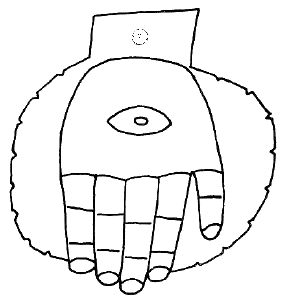
|
|
Prehistoric Designs -- Moundville, plate 33 The prehistoric Indian site of Moundville, Alabama, is located on the Black Warrior River in Hale County. More than two dozen truncated earth mounds were built there by the Indians. The first extensive excavation at this site was directed by Clarence B. Moore. It was recorded in the Journal of the Academy of Natural Sciences of Philadelphia, which published two volumes dealing primarily with Moundville. They were, Aboriginal Remains of the Black Warrior River. ... 1905 (BWR) ... Skull and Hand and Eye; about 3-1/2" wide, on entire side of cup (BWR-62 and 63). Bone, Hand, skull, cross, arrow-type object, and star in oval (BWR-147).
|
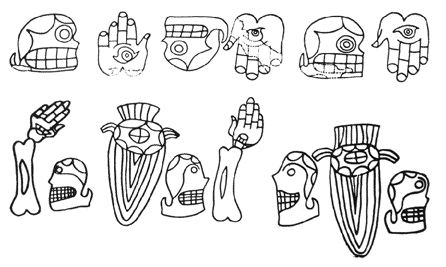
|
Prehistoric Designs -- Moundville, plate 36 Designs after Clarence B. Moore and the Alabama Museum of Natural History collection, Mound State Monument, Moundville, Alabama. These are not tracings; they are only quickly made free-Hand drawings, but they are closely representative, and show the variety of typical cult designs and combinations of designs used at Moundville. Various bands of designs with cult symbols including the Hand, bone, and skull symbols. (These include, Moore, BWR 22, 63, 147, 153, and MR 45, 46.) Various bands of designs showing the ogee or open Eye (or female symbol?)
|

Prehistoric Designs -- Moundville, plate 37
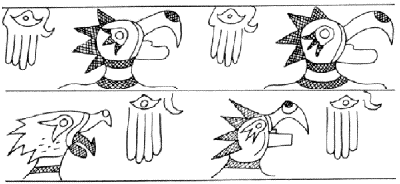
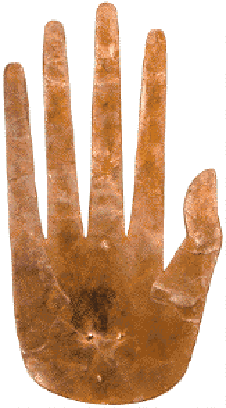
Hopewell Hand of mica |
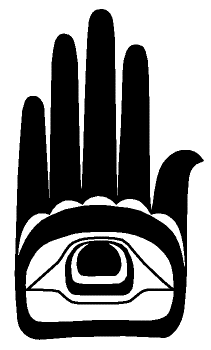
Haida Eye in Hand design |
|
KUMUSH The 'old man of the ancients' in Modoc Indian legend, Kumush descended with his daughter to the underground realm of spirits, and having spent six days and six nights there, decided to return,and bring some of the shades with him. He collected the bones in a big basket, and set off, but was balked twice by the long and steep climb out of the netherworld. Every time he fell,the bag opened and the bones leapt out, taking flesh as the spirits whose bones they were, shouting and singing. The third time he shouted angrily to the spirits to remain quiet,and he managed the climb out of the underworld, bringing the spirits with him, including those that begot the tribe of the Modocs. Then he finished his arrangement of the world, travelled along the sun's road, and built for himself and his daughter a house in the middle of the sky, where they still live today.
source: http://www.clubi.ie/lestat/ofgodsk.html
Modoc Indian War in California and Oregon lava beds, 1872-73
More on the Modoc: go to http://www.tpl.lib.wa.us/cgi-win/fulltcgi.exe/Modoc_War|indian.bat\modoc.war |
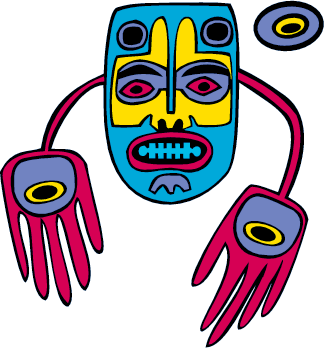
|
|
great site on "Eye-in-Hand amulets" & the hamsa Hand at the Lucky W Amulet Archive
by Catherine Yronwode ... The Eye-in-Hand is an old and still popular apotropaic amulet for protection from the evil eye. [In Turkey, Azerbaijan, Iran and Greece the protection-against-the-evil-eye amulet is known as a nazar. tpk] Combining the imagery of Greek and Turkish blue eye charms with the downward-facing Arab and Israeli hamsa hand, the Eye-in-Hand is common in India and the southern Mediterranean region.The three modern Eye-in-Hand amulets shown here are 3/4 of an inch to one inch in length. From left to right they are:
|
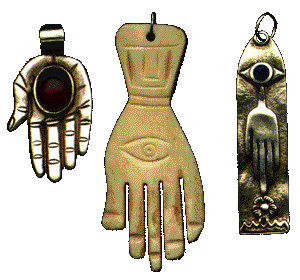
|
Jainism: Jain Principles, The Hand implies "abhaya mudra", ie, no fear. The word inside is "ahimsa" - non-violence. The chakara implies dharma.
- Professor Yashwant K. Malaiya 8 Jan 2001
| 
|
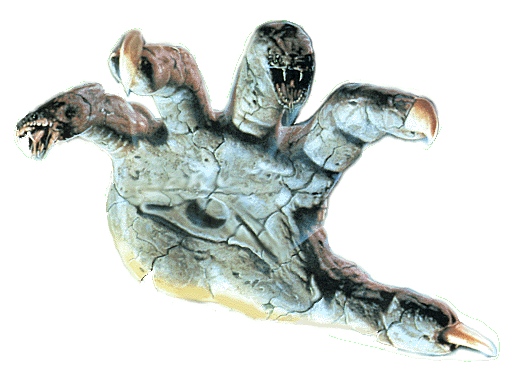
|
an Eye in Hand in the movie "Netherworld" with the Ouidjat - Eye of Horus drawn on its palm, flies through the air and strangles a bad guy
Netherworld (1991) http://e1.eonline.com/Facts/Movies/0,60,24804,00.html 1981-1997 Videolog. All rights reserved. |
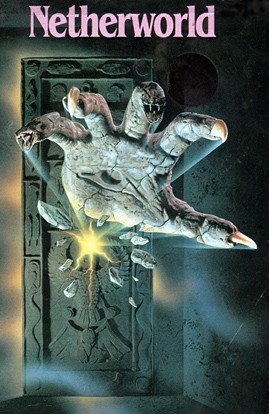 |

|
Mon, 16 Feb 1998 17:52:47 -0400 http://www.hersalon.com/shrine/music/indigo/faq1.htm 5.6. What does the tattoo on Amy's forearm mean?
Amy explained the tattoo in "Fashion" magazine (circa 1989):
Niki Pantelias, founder of the original Indigo Girls mailing list, |

|
The MUAB Film Committee is a group of student volunteers at Arizona State University in
Tempe, Arizona. We run the Union Cinema, a 225-seat theater in the Memorial Union. We choose the films, advertise them, run the concessions stand, and even project the films ourselves! ...
Currently, the Film Committee is gearing up for the
| Membership is open to all ASU Students. Our meetings are held weekly at 3:00 PM on the third floor of the Memorial Union in the MUAB conference rooms. Any questions? Call us at (602) 965-6822.
Last updated: November 29th, 1995 |
|
 from a 1998 almanac |
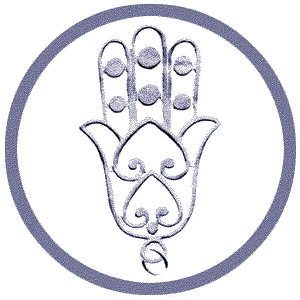 | a little work for a friend... you already have the same but not with these colors.... BuBBle, french studient... |
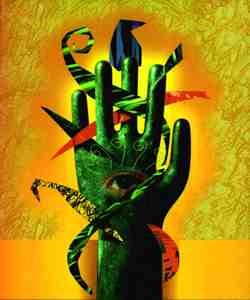
|
Eye in Hand by Craig Frazier using Photoshop, on cover of Xaos Tools Artist in Residence Fresco collection
All contents of Critique Magazine's Web site and of Critique magazine © Critique Magazine, 1996-1998. All Rights Reserved. |
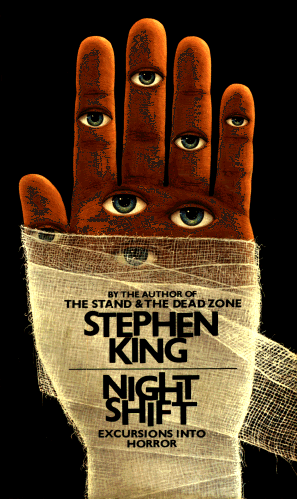
|
cover (no credit)
Night Shift
First Signet Printing, February 1979
thanks, George.
|
|
Brian J. Bonislawsky's ASTIGMATIC ONE Eye FOUNDRY http://www.astigmatic.com the Astigmatic One Eye Foundry is YOUR source for Fonts, Art, Design, Web Design, and Tutorials ... astigma@comptechdev.com |
|
 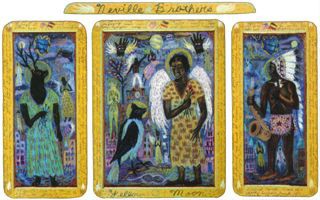 
|
Tony Fitzpatrick cover art
Yellow Moon 1989
Produced by Daniel Lanois
Tony Fitzpatrick lives in Chicago and has shown his paintings, drawings, and
etchings extensively across the country. He is also a poet, author ( Dirty
Boulevard ), actor and radio host, and is represented by Janet Fleisher Gallery
in Philadelphia.
|
|
An Eye in Hand If only hands could see.
#11294 Ron Chapple, FPG International |
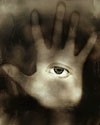
|

|
Eye in Hand Productions Web Site Design and Publishing http://www.agate.net/~paulleb/Eye_In_Hand/index.html P.O. Box 361, Skowhegan, Maine 04976 paulleb@agate.net |
|
2 May 1999. In response to your request for further references to the Hand/Eye pattern I am attaching 2 files with scans of photos taken from wall painting in the Neolithic town of Catalhuyok in south central Turkey. The paintings are part of the decoration in a shrine dedicated to the Great Mother and her daughter dating about 6100 B.C.E. Your page is fascinating. Thanks for doing it... Cheers.... Maya Heath |
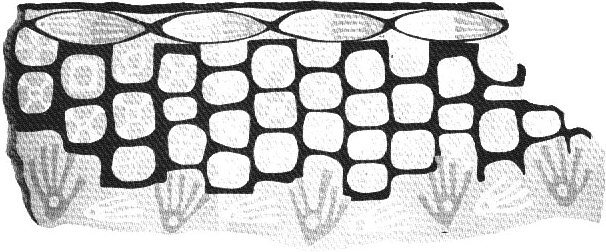

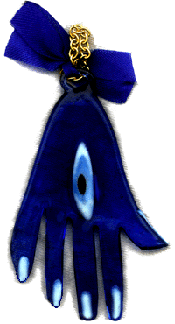 |
Blue Glass Anti-Evil Eye Charm: Eye-in-Hand 4" x 2"; large blue glass Hand with Eye in palm, white glass fingernails, complete with a blue ribbon and brass chain for hanging in a window. $4.00 The Lucky Mojo Curio Co. 6632 Covey Road, Forestville, California 95436 "The most popular form of Eye-in-Hand amulet is probably the blue glass charm from Turkey [nazar]. In the region of the eastern Mediterranean and Aegean, the evil Eye is generally conceived as blue in colour. Thus a blue Eye-charm is considered most efficacious in warding off the influence of envious gazing. The blue glass Eye-in-Hand charm shown here is from Turkey. It is 3-3/4 inches in length and is equipped with a hanging chain and decorative blue ribbon. The Turks are prolific designers and manufacturers of this type of apotropaic charm. Being so large and fragile, these glass objects are not made to be worn as jewelry, but rather hung on the wall, probably over the door or near the bed of a baby. Other blue glass wall-hanging amulets from Turkey include a dark blue all-seeing Eye, a pale blue horseshoe covered all over wth small eyes, and a large circular blue Eye from which is suspended a gold-toned horseshoe and a bunch of plastic grapes. In addition, the Turks make a smaller, jewelry-like blue glass amulet i call eyes-all-over." |
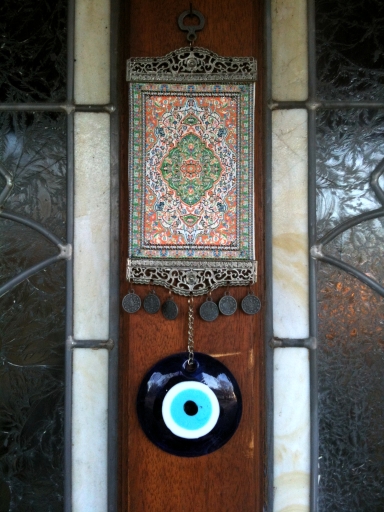 |
Why blue? Note that the majority of people who use the blue-eyed protection-against-the-evil-eye amulet are overwhelmingly brown-eyed. Brown-eyed people wearing "protection" against evil by using a blue-eye image calls into question the disparity between brown and blown and the significance of the nazar's blue eye.
- Is it xenophobia - fear of strangers - with blue eyes? - from Europe? - an imbedded memory of the death & destruction brought to the eastern Mediterranean by the Christian Crusades? - the "blue-eyed devil"? - Is the magic a type of mirror/boomerang/reversal that reflects blue-eyed evil back onto the blue-eyed evil-doers? - Or does the blue-eyed amulet attract the positive power of blue eyes to protect the brown-eyed wearer? - Or is the color blue simply incidental? - an effect of the access & ease with which cobalt interacts with glass? tpk 2011 |
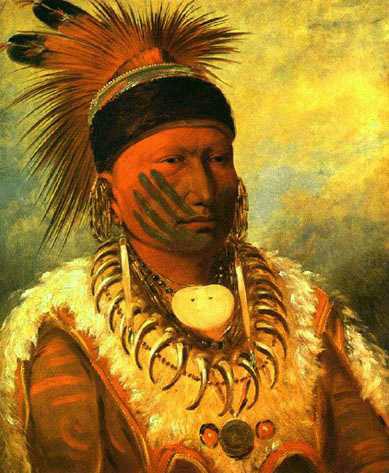 |
The White Cloud The White Cloud, Chief of the Iowa, stands before us in front of a cloudy, lit-up evening sky. What impresses us first about this portrait is the exotic appearance of the chief. Yet at the same time the conservative style with which Catlin has approached this new subject appears strange: he painted the inhabitants of the wilderness in the same way as he painted prominent personalities in Philadelphia before. He may not have achieved the subtle excellence of his friend Rembrandt Peale, but he certainly mastered the art of portraiture. With the illumination a certain drama has been added to an otherwise rigid composition. He has depicted his model in half profile to emphasize the striking shape of the head which he has shown slightly from below so as to highlight this leader's pre-eminent personality. The precise representation of the headdress emphasizes the Chief's dignity. Catlin has devoted his full attention to the face and The White Cloud's expression. The eyes have been painted with such care that they seem to tell us of a prudent and experienced middle-aged man. Light and shadow model the facial features without beautifying them. Everything else takes on a secondary role, important but not essential.
|
|
spiral in Hand )( the healing Hand ...
|
FRAGS are a collection of sensitively rendered rock art replicas, Native American designs and original works by artist John Running. His inspiration comes from the mystique surrounding these ancient wonders and by his respect and concern for the natural world around us. No sites or actual rock art images were disturbed while creating this FRAG collection. John's own drawings, photographs and field notes are used as a reference while creating the original sculptures for these pieces. They are perfect for wall hanging or displaying in a stand. Each FRAG is Hand-painted in an 'aged stone' finish of natural colors. The appearance would lead you to believe that they are heavy stones, yet you can easily hang them by a thumbtack. Each FRAG measures approximately 6" x 11" and costs $25.00 plus shipping and handling. | 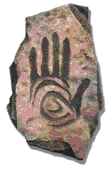 |
 |
talk to the Hand ... the earless, mouthless, deaf and dumb Hand
Talk to the Hand
|
9 May 1998
Hi,
It has helped me in working toward what "the Eye in Hand" means to me as
Thank you, |
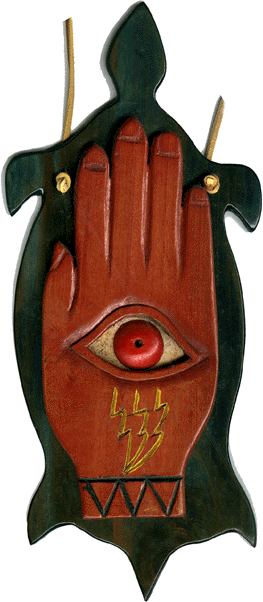 |
Eye-in-Hand on a turtle painted wood carving wall hanging on a leather thong 12.75" x 5.5" inscription on back:
|
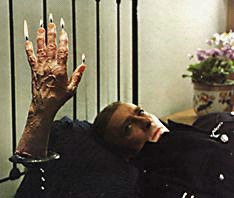
|
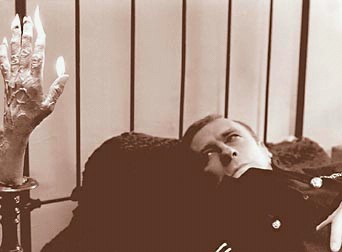
Eye-in-Hand on the back
Strict Christian Scottish policeman Sergeant Neil Howie |
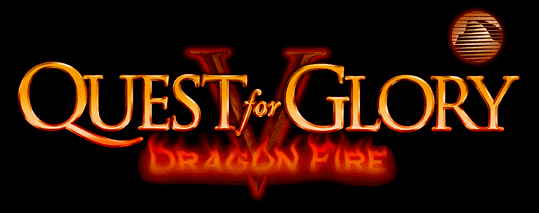
|


|
| composition in process ][ last updated: 14dec11 created: dec96 ][ tom@kunesh.net
|
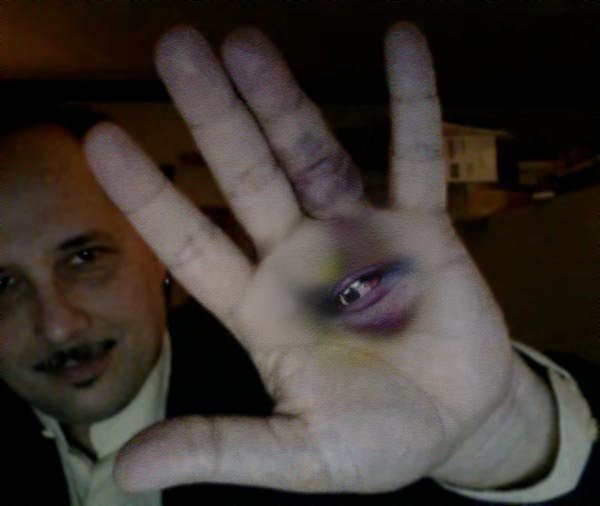 | tom's eye-in-hand
by Barry Radun
tripped&fell over a little 18" fence surrounding the tiny Beck family cemetery, dislocated my left ring-finger, pulled & re-set it myself at the scene, then ER nurse re-set it again. beautiful all the purple black&blue. |
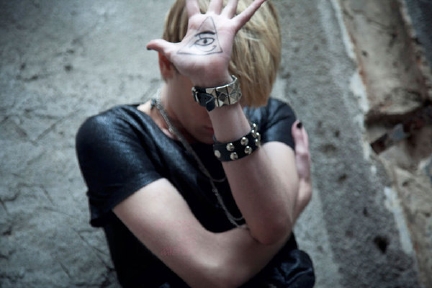
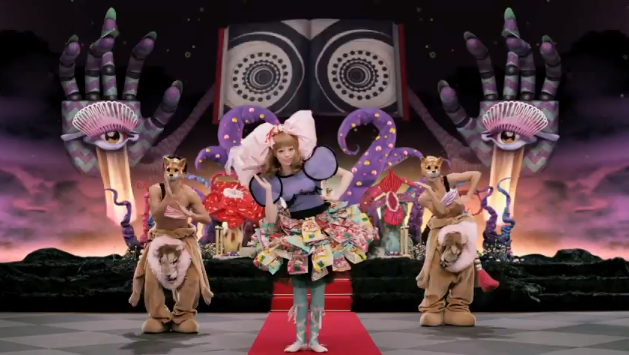
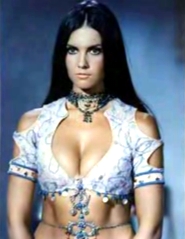
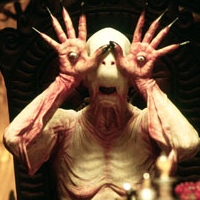

 Craig Frazier is the owner of Frazier Design, San Francisco. He is a designer, creative director,
Craig Frazier is the owner of Frazier Design, San Francisco. He is a designer, creative director, 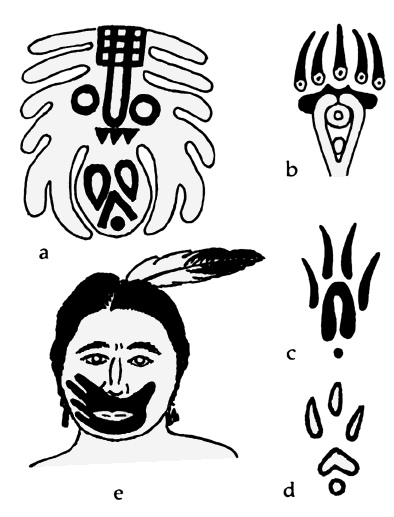

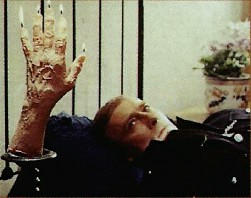
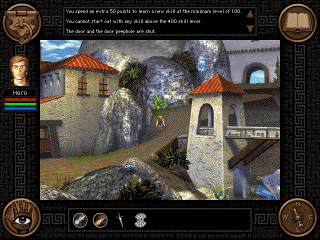
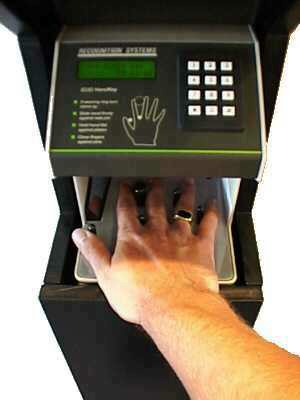
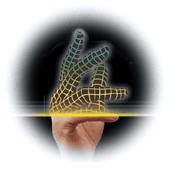 Hand key machine
Hand key machine 